Exploring the World of Wakeboard Park Boards
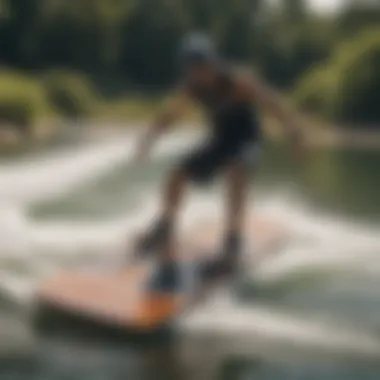

Intro
Wakeboard parks are becoming hotspots for both seasoned pros and curious newcomers eager to glide across the water. This niche realm of watersports demands specialized gear, notably the wakeboard park boards. Unlike standard wakeboards, these boards are uniquely crafted to tackle the challenges of dedicated parks filled with ramps, rails, and other features. This article dives into the nuances of wakeboard park boards, highlighting their design intricacies, the performance features that elevate rider experiences, and the essential maintenance routines to keep them in top shape.
Techniques and Skills
Essential Techniques for Beginners
For novices stepping onto the wake for the first time, mastering basic techniques is crucial. Here’s a rundown of fundamental skills to get you rolling:
- Stance: Begin by finding your comfortable stance. Are you a goofy footer or regular? Getting this down helps with balance.
- Body Positioning: Keep your knees bent and body low to the board. Gravity does the trick; flexibility is your friend.
- Weight Distribution: Leaning slightly back helps with planning and reduces the chance of face-planting on impact, a trusty lifesaver for first-timers.
"Wakeboarding is not just about cutting through the water; it’s about finding your flow and style on the board."
Advanced Skills for Experienced Watersport Enthusiasts
As you progress, things get exciting with tricks and stunts. Here are a few skills to master for those looking to elevate their wakeboarding game:
- Air Tricks: Mastering jumps and spins can add flair to your routine. A solid pop off the wake gives you that lift needed.
- Rail Riding: This is a game changer. Learning how to grind on rails opens a world of creativity and style. Practice makes perfect here, so don’t shy away from trying often.
- Inverts and Flips: For the brave-hearted, attempting flips and inverts can take your wakeboarding to another dimension. Just remember, safety first!
Equipment and Gear
Must-Have Gear for Each Watersport
Using the right equipment makes a world of difference. Here’s a checklist of essentials surfers and wakeboarders should consider:
- Life Jackets: Safety gear is non-negotiable, especially for beginners. Choose one that fits snugly, allowing flexibility.
- Wetsuits: Depending on the season and water temperature, a wetsuit can protect against chill and abrasions.
- Bindings: Ensure your bindings are comfortable yet secure. They should allow for ease of entry and exit.
Tips for Selecting the Right Equipment
Picking the right gear is as important as mastering techniques. Here are a few tips:
- Know Your Style: Are you a freestyle rider or more into cruising? Your board should match your riding style.
- Choose the Right Length: A shorter board enables spins and tricks, while a longer one aids stability. Find a balance depending on your comfort level.
- Test Before You Commit: If you can, try out several boards before purchasing. Everyone's feet and styles are different, and what works for one might not work for another.
Understanding wakeboard park boards is pivotal for enhancing your skillset and performance in the water. Selecting the right board can significantly influence your experience. As you progress, so too should your knowledge of gear, techniques, and parks that cultivate skills in the vibrant world of wakeboarding.
Prolusion to Wakeboarding
Wakeboarding is more than just a sport; it's an exhilarating fusion of surfing, snowboarding, and waterskiing, captivating enthusiasts with its adrenaline-pumping action. This article steps into the deep end to explore wakeboard park boards, essential tools that significantly enhance the wakeboarding experience. The significance of this segment cannot be understated. Understanding wakeboarding lays a solid foundation for anyone keen on diving into the specifics of park boards, which cater to the unique needs of riders who frequent these specialized environments.
The allure of wakeboarding is profound; the challenge it presents encourages riders to push their limits, develop their skills, and find creative freedom on water. From the rush of catching air off a ramp to executing intricate tricks on the water, wakeboarding nurtures a sense of community among participants, invariably leading to lasting friendships and unforgettable experiences. Not only does engaging in wakeboarding foster physical fitness, but it also enhances mental resilience and coordination. All of these elements contribute to the thriving subculture of wakeboard parks, making it vital to grasp their foundational importance.
A Brief History
Wakeboarding as a sport has roots that hark back to the late 1980s. A blend of various watersports was born when Idaho resident, Tony Finn, sought a fresh perspective on waterskiing. By adapting a kneeboard and incorporating aspects from surfing, the first wakeboard was crafted. This was no capricious invention; it ignited a movement that transformed weekends into a thrilling affair on the water. Over the decades, manufacturers began recognizing the untapped market potential, as riders sought more specialized equipment, thus giving rise to an industry that thrives today.
Wakeboarding hit mainstream popularity in the 1990s, fostering competitions and even landing a spot in the X Games. Fast forward to now, with innovations in design and technology, the sport has progressed immensely, making it accessible to everyone from first-time riders to seasoned pros. There's an undeniable sense of legacy and progress that intertwines the history of wakeboarding with its modern-day iteration.
Wakeboarding vs. Other Watersports
What elevates wakeboarding above other watersports? It's not merely the vehicles or the environment; it’s the versatility that comes with the sport. While traditional skiing does promise speed on water, wakeboarding adds a layer of artistic expression that relies heavily on personal style—something beginners often find compelling. Riders enjoy the sensation of "catching air" and then performing spins, flips, and other tricks.
Here are some distinct factors that set wakeboarding apart from its counterparts:
- Accessibility: Unlike surfing, where the need for waves is paramount, wakeboarding can be pursued in various water settings with powered boats or at parks using cable systems.
- Versatile Tricks: Riders can learn numerous tricks and spins, making it an endless playground for innovation.
- Community Aspect: The environment around wakeboarding is highly social, with parks often serving as communal hubs. This offers not only competition but also camaraderie that keeps people returning.
Thus, understanding wakeboarding is vital for grasping why wakeboard park boards must be examined; they directly impact a rider's performance and style. As we delve deeper into the specifics of wakeboard park boards, it becomes clear that choosing the right equipment can amplify the overall experience—hence setting the stage for a comprehensive exploration ahead.
Understanding Wakeboard Park Boards
To truly grasp what makes wakeboard park boards special, one must dive deep into their defining features and differences from traditional wakeboards. Wakeboarding in parks presents unique challenges, rewards, and circumstances, which play an essential role in shaping the design and functionality of the boards used for this thrilling activity. The better one understands these boards, the more effectively they can choose the right one for improved performance and enjoyment on the water.
Defining Wakeboard Park Boards
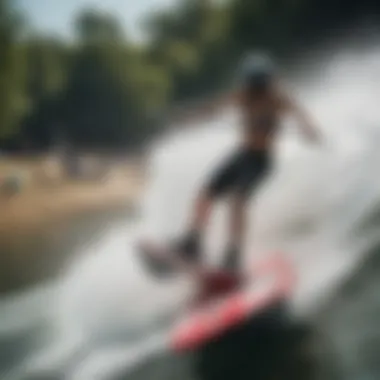
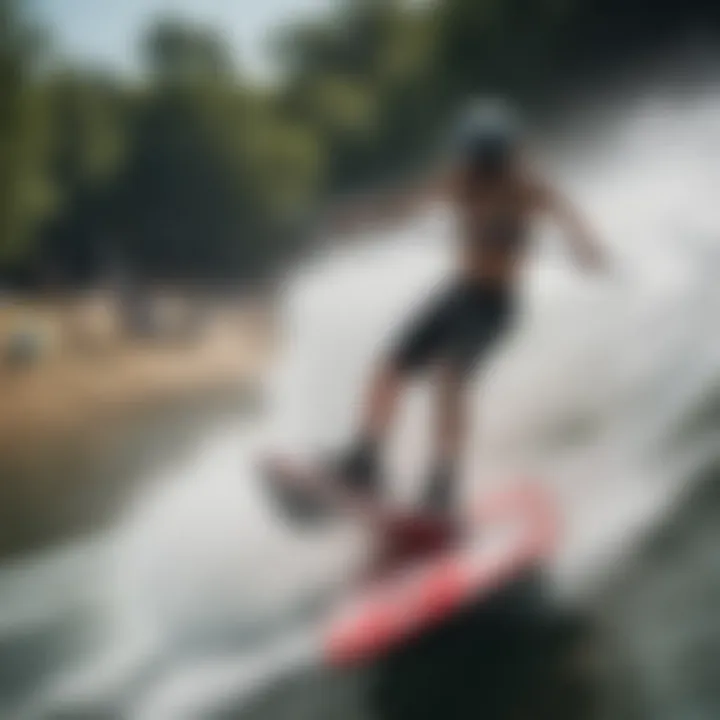
Wakeboard park boards are specifically crafted for the recreational and competitive environments found at wake parks. These parks often include obstacles such as rails, kickers, and sliders, which provide a platform for tricks and aerial maneuvers. Unlike standard wakeboards, park boards offer a blend of durability and perfected design tailored to handle the rigors of these features. Most notably, they come equipped with a flat base, softer flex, and reinforced edges to minimize damage upon impact with these structures. This combination grants riders the ability to smoothly slide over obstacles while maintaining stability.
Additionally, many park boards boast a reduced rocker profile, making them less cumbersome in the air while allowing for better responsiveness on water. This specific structure aids in speed and gives riders the power to pop off obstacles cleanly. It's also not uncommon to find park boards sporting a wider stance, which helps in landings and overall control during advanced tricks.
Key Differences from Traditional Wakeboards
When one compares wakeboard park boards to traditional ones, several distinctions come to light:
- Shape and Flexibility: Park boards tend to have a different shape and are generally more flexible. This flexibility aids in the versatility required for trick execution on various park features. Traditional boards are built for straight-line speed and smoother surfaces rather than diverse conditions.
- Base Design: The bottom surfaces of wakeboard park boards are often flatter with fewer channels or fins, unlike their traditional cousins. This design allows for a smoother ride on rail features, reducing snagging while enabling riders to better glide along the surface.
- Durability Features: Given the park boards’ roles in riding over various surfaces, manufacturers frequently incorporate tougher materials that bolster durability. Traditional boards may concentrate more on weight reduction for maximum speed, but park boards require that balance towards robustness to handle the wear and tear of rails and other custom structures.
- Rider Style: Park boards are generally used by trick-focused riders who prioritize technical skills over mere speed. In contrast, traditional boards cater more to those seeking high-speed performance on smooth lake waters.
Overall, gaining insight into these key differences allows riders to make informed decisions regarding which type of board suits their specific riding style, enhancing both safety and performance during their time on the water. The right choice can vastly influence a rider's experience, whether they're performing tricks or simply navigating through the park environment.
Design Features of Wakeboard Park Boards
When it comes to wakeboarding, the design of the park boards cannot be overstated. These boards are more than just a means to glide over water; they are carefully engineered to maximize performance and enhance the overall riding experience in park settings. Understanding the unique design features of wakeboard park boards helps riders make informed decisions that align with their skill levels, riding styles, and specific needs on various park features.
Construction Materials
The materials used in the construction of wakeboard park boards directly influence their flexibility, durability, and performance. Most wakeboard manufacturers utilize a combination of fiberglass, foam, and wood.
Fiberglass is often layered in various weights and orientations to create a strong yet lightweight board. This offers the necessary strength to endure the impact of various tricks while maintaining a degree of responsiveness.
Foam core is filled within the board structure to provide buoyancy and shock absorption qualities, which are vital for tackling rails and ramps. For those looking for an eco-friendlier option, bamboo is gaining in popularity as it provides a sustainable choice without sacrificing performance.
Key Takeaway: The choice of materials in wakeboard park boards not only impacts their performance but also affects their longevity and responsiveness in the water, leading to a more enjoyable ride.
Shape and Size Considerations
The shape and size of a park board play a crucial role in its handling characteristics. Parks often present a unique mix of features, from kickers to rails, which necessitate specific board designs.
- Length & Width: Shorter boards tend to be more maneuverable, great for tricks and tight spaces, while longer boards offer stability and speed. Width, on the other hand, affects buoyancy and the ease of sliding on rails.
- Rocker Types: Park boards typically have a continuous rocker, allowing smooth transitions from edge to edge while providing a forgiving ride for landings. Some boards balance a hybrid rocker for versatility in various situations.
- Tips and Tails: A broader nose and tail can aid in the execution of tricks while offering extra lift when attempting jumps. Some riders may prefer a tapered design for more responsive edge control.
In Summary: The right shape and size can make all the difference in how well a rider can execute stunts and maintain control while navigating the park's challenges.
Base Design for Park Features
The bottom, or base, of a wakeboard is one of the most pivotal components, especially for riders who frequently use a variety of park features. Different base designs cater to different riding styles and preferences.
- Flat Bases: These designs are ideal for beginners, offering stability and allowing for easy learning on flat water and rails. They promote smoother rides and minimize the likelihood of catching edges.
- Spine Technology: Adding a spine down the center can enhance flex and maintain pressure, providing a comfortable feel when landing. This design helps reduce the risk of nose dives during landings.
- Cavities and Channels: Many modern boards include channels or grooves that improve edge control and increase holding power while navigating turns, ensuring a snag-free experience on rails.
"Selecting the right base design is critical for maximizing performance while engaging with features found in parks, transforming ordinary runs into extraordinary experiences."
Conclusion: The intricate design features of wakeboard park boards are integral to a rider's performance. By understanding the implications of construction materials, shape and size, as well as base design, riders can better choose boards that suit their needs and enhance their wakesport adventures.
Selecting the Right Wakeboard Park Board
Choosing the right wakeboard park board is not merely about picking up whichever one catches your eye; it’s a decision that could significantly influence your experience on the water. Every board has its unique traits that cater specifically to a different riding style and skill level. This section explores the various facets that one should consider when selecting a wakeboard park board, ensuring you make a well-informed choice.
Skill Level Considerations
When it comes to skill levels, one size certainly does not fit all in the world of wakeboarding. A novice rider should be cautious with boards that are too advanced. For beginners, boards with a wider base provide enhanced stability and support, helping to build confidence. These boards often feature softer flex patterns that can help cushion any mistakes or stumbles.
Conversely, advanced riders may find more benefit in boards that offer a stiffer construction. This allows for greater control and responsiveness, which is crucial when executing complex tricks or navigating challenging park features. A well-rounded rider will likely invest in a board that can accommodate both beginner-friendly and advanced techniques as their skills evolve.
"Selecting the right board based on skill level is your first step in avoiding a faceplant while making the most of your time on the water."
Riding Style Preferences
Your individual riding style plays a pivotal role in determining the ideal wakeboard park board for you. Riders who favor tricks and jumps may want to consider boards with a more aggressive rocker. This design facilitates explosive pop off the water, perfect for hitting ramps and rails. On the other hand, those who prefer a more relaxed cruise may lean towards flatter boards that provide a smoother ride and allow for easy transitions on flat surfaces.
Additionally, the setup of the fins on the board can significantly impact your ride. Some boards come with removable fins for versatility, allowing riders to customize their handling and stability according to their preferences. The balance of control versus freedom has major implications on how you feel during your ride.
Budget and Brand Options
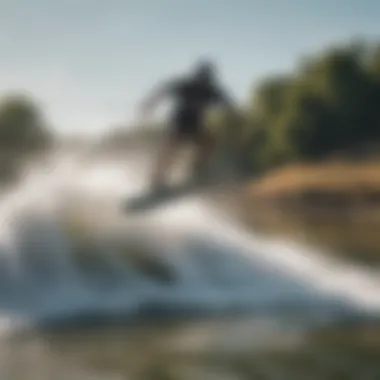
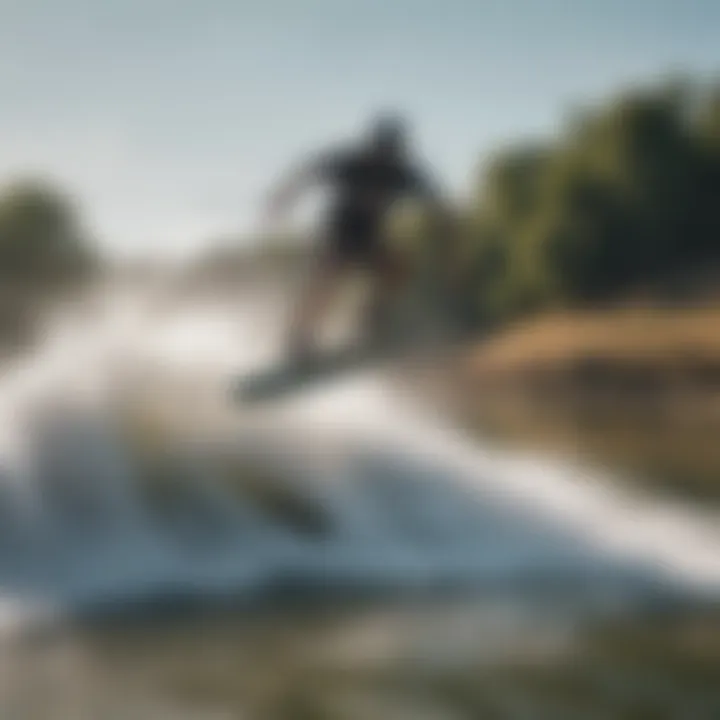
Let’s face it, budget is often a deciding factor in any purchase, and wakeboard park boards are no exception. Options range from budget-friendly models from less prominent brands, which might be suitable for beginners, to high-end boards crafted by the likes of Liquid Force or Hyperlite.
When selecting a board, consider how often you'll be using it; frequent riders may justify spending a bit more on a quality board that can withstand the wear and tear of regular use. Moreover, performance and durability play a critical role in this decision. Models priced higher often offer advanced technology and materials that enhance your riding experience.
Also, don't overlook second-hand options. Sometimes, you can find a fantastic board that is lightly used at a fraction of the cost. Just ensure to inspect it for any hidden damages and wear.
In summary, the task of choosing the correct wakeboard park board involves careful consideration of several elements. The right match can turn an ordinary session into an exhilarating ride that sculpts your skills and confidence on the water.
Performance Characteristics
When discussing wakeboard park boards, the term "performance characteristics" is pivotal. These features significantly influence how a board handles in different conditions and environments, particularly within a park setting. Riders, whether novices or seasoned athletes, learn to appreciate how these characteristics affect their experience on the water. Key performance qualities derive from the flexibility, edge control, and overall stability of the board.
Flex and Response
Flexibility is a crucial aspect of a wakeboard park board. The degree of flex in a board determines how well it can absorb shocks from landings and manage transitions between features. A board that is too stiff may lead to rough landings, whereas excessive flexibility might not provide adequate control during tricks. Most park boards aim for a medium flex rating, which offers a balance conducive for both jumping and sliding across obstacles like rails and boxes.
Benefits of Flex in Wakeboard Park Boards:
- Shock Absorption: A board with the right amount of flex can cushion impacts, reducing the likelihood of injuries.
- Dynamic Response: How a board responds to a rider’s movements is influenced by its flex pattern. An appropriate flex setup helps riders execute tricks more fluidly.
- Versatile Performance: A flexible board is more forgiving on various park features, allowing a rider to adapt their styles easily.
In practice, choosing the right flex can enhance a rider's overall performance, enhancing the fun factor in the park. It's worth noting that factors such as personal riding style, weight, and skill level should be taken into account when selecting a board with the right flex.
Edge Control and Stability
Edge control plays a vital role in allowing riders to navigate park features and water conditions effectively. The design of the edges can dictate how sharply a board can turn and how well it grips during slides. Riders often find that boards with sharper edges offer more aggressive turning capabilities, which is desirable for making quick maneuvers around obstacles.
Stability in the Context of Wakeboarding:
- Types of Stability: Stability encompasses both directional stability while riding straight and lateral stability while edging or during tricks. Boards that maintain stability in both aspects allow for smoother rides.
- Weight Distribution: A well-designed wakeboard evenly distributes weight, enhancing control and stability. Riders will find that weightier boards often provide more stability at high speeds, while lighter boards can be beneficial for executing tricks.
- Base Shape: The bottom contours affect water flow, influencing both speed and maneuverability.
To sum up, understanding the performance characteristics of wakeboard park boards—specifically, flex and edge control—enables riders to make informed choices tailored to their unique riding styles.
Important Note: The right board selection can fundamentally change a rider's experience, ensuring improved safety and skill development in the park.
The importance of these performance traits cannot be overstated; they set the stage for growth and enjoyment in the sport of wakeboarding.
Maintenance of Wakeboard Park Boards
Keeping your wakeboard park board in top condition isn't just about prolonging its life; it's integral to your performance on the water. Boards endure a lot of wear and tear from constant impacts, exposure to water, and the occasional mishap on obstacles. Regular maintenance ensures that the board remains responsive, efficient, and safe for use.
Regular Inspections
Regular inspections serve as the first line of defense against deterioration. Before every ride, it’s a smart move to check your board for cosmetic and structural damage. Look out for:
- Dings and dents: These can affect the board's performance and stability.
- Delamination: If the top layer separates from the core, your board might lose its integrity.
- Fin conditions: Ensure that fins are properly attached and not too worn down.
Performing these checks can save you from potential accidents and costly repairs down the line. Additionally, a monthly thorough look is well worth your time—both for safety and performance.
Cleaning and Storage Tips
Yes, water may be your board's natural habitat, but that doesn’t mean it doesn’t need some TLC afterwards. After every session, rinse your board with fresh water to get rid of salt, sand, or dirty residues. A quick scrub with a soft brush ensures that any stubborn dirt gets removed, keeping the base super slick for your next outing.
For storage, keep your board in a cool, dry place away from direct sunlight. Avoid stacking heavy objects on top of it, since that can warp its shape over time. Using a board bag can further protect it from scratches and dust when not in use.
Repairing Common Damages
Sometimes, accidents happen and damage is unavoidable. Having a plan for repairs can keep your board in the game longer. Here are some common damages and how to tackle them:
- Surface scratches: These can often be buffed out using a simple fine-grit sandpaper. If you have a gel coat, applying a small amount of repair kit solution brings back that smooth finish.
- Cracks in the base: If you spot a crack, it’s best to use a marine epoxy for a quick fix. Ensure that it’s completely dry before you hit the water again.
- Fin damage: It’s often easier and cheaper to replace a damaged fin than to try repairing it. Make sure to carry a spare when out in the water.
"Preventive care goes a long way. Treat your board well, and it will reward you with performance and longevity."
In summary, prioritizing maintenance is crucial not only for the board's lifespan but also for your safety and performance on the water. A well-maintained wakeboard means fewer surprises and more time enjoying the ride.

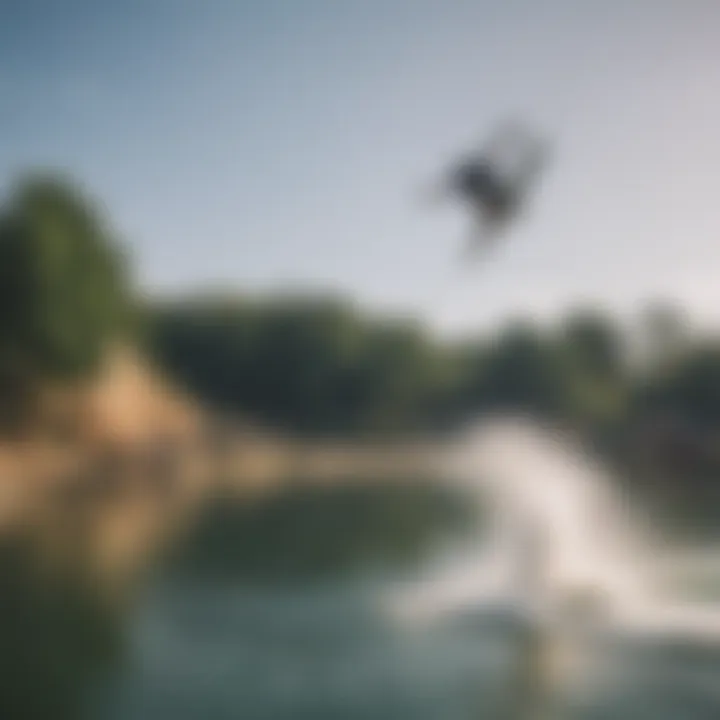
Brands to Consider
Selecting a wakeboard park board goes beyond mere aesthetics. The brands you choose often dictate the experience you will have on the water. Each manufacturer brings its own philosophy, innovation, and quality assurance to the fore. This section details the importance of understanding brands associated with wakeboarding, which can help enthusiasts make informed choices that best suit their riding style, skill level, and budget.
Top Manufacturers in the Market
In the realm of wakeboarding, several brands have carved out a niche for themselves, gaining reputations that riders trust. Here are a few top manufacturers:
- Liquid Force: Known for its blend of performance and durability, Liquid Force consistently pushes the envelope in design. Their boards feature customized flex patterns and lightweight materials which enhance both stability and control.
- Hyperlite: Often regarded for their innovative technology, Hyperlite is a favorite among seasoned riders and new arrivals alike. Their boards, designed with a focus on versatility, cater to various skill levels. The grip they offer in waters is simply unmatched.
- Ronix: This brand is often seen as a trendsetter within the wakeboarding community. Focusing heavily on comfort and performance, Ronix blends fun and functionality in every ride.
- Byerly: Melding traditional crafting with modern techniques, Byerly boards stand out for their unique designs and construction methods. If you're looking for a board that feels good and performs even better, this could be your match.
- Slingshot: Offering a range of boards that are light and flexible, Slingshot aims to elevate performance without compromising durability. Riders often praise their boards for the pop they offer off ramps.
Understanding these brands means you can be more deliberate in choosing a board that complements your riding experiences. Each company emphasizes different aspects, such as flexibility or stiffness, and the choice ultimately affects your ride.
Brand Comparison and Reviews
Now that we've identified significant players in wakeboarding, it's time to look deeper into the specifics that set them apart.
- User Feedback: Many riders provide insights about their experiences through platforms like reddit.com and various wakeboarding forums. Listening to fellow wakeboarders ensures you can gauge real-world performance. Recurring praises or complaints about a board can guide your selection.
- Performance Metrics: Users often highlight factors such as speed, maneuverability, and overall control for each brand. Boards with noteworthy edge control receive favorable feedback, leading to lesser accidents and improved confidence for beginners.
- Price and Value: While some brands can be pricey, many enthusiasts argue that the higher cost reflects improved durability and technology. Comparisons between your preferred brands can solidify your purchasing decision.
- Aesthetics and Personal Preference: Not to be overlooked, the visual appeal of a board often resonates with riders. A board that matches your style can enhance the emotional connection to the sport.
"A good brand isn't just about the name; it's about the experience it delivers on the water. Knowing what you can expect helps riders choose wisely."
To cap it all off, being familiar with the brands in the wakeboarding market is crucial not just for sport but for the community engagement that surrounds it. Choosing the right board encompasses performance, feedback, and relationships you can forge through shared experiences. Riders should never underestimate how brand loyalty and informed choices play a huge role in their wakeboarding journey.
The Role of Wakeboard Parks
Wakeboard parks play a central role in shaping the experience of both novice and experienced riders. They serve not only as a venue for thrilling sports but also as vibrant communities where individuals gather to share their passion, learn from each other, and refine their skills. Parks are designed capably to enhance the wakeboarding experience, providing specialized features that are essential for honing techniques and creating a safe environment for fun.
Community Building and Events
Wakeboard parks are much more than just a place to ride; they are the beating heart of a dedicated community. Regular events, such as competitions and festivals, draw together riders from various backgrounds, fostering relationships and camaraderie among participants and spectators alike. This gathering creates a supportive atmosphere that encourages both personal and collective growth.
Engaging in such activities not only strengthens the bond among riders but also amplifies local interest in wakeboarding as a sport. Whether individuals see themselves as seasoned pros or beginners, the shared passion for wakeboarding cultivates a sense of belonging.
Moreover, parks often host organized clinics and workshops, where experienced instructors teach techniques to up-and-coming riders. These learning opportunities are essential for those looking to elevate their skills or break through barriers, while also helping instructors share their love for the sport.
"The beauty of wakeboard parks lies in their ability to bring diverse riders together, promoting a culture of support and shared passion."
Learning and Progression Opportunities
One cannot underestimate the importance of learning and progression within the realm of wakeboarding. Wakeboard parks are equipped with a variety of obstacles, ramps, and features that allow riders to experiment and improve their skills in a controlled environment. Riders can practice their jumps, tricks, and maneuvers without the added unpredictability of natural water bodies.
In addition, beginner-friendly areas often exist, featuring smaller ramps and gentle obstacles tailored for those just starting. This encourages people of all ages to take up the sport. The gradual introduction of progressive features helps riders build confidence without risking injury, which is crucial for retaining newcomers interested in the sport.
Parks also provide an informal setting where riders can observe and learn from one another. Watching fellow riders tackle obstacles adds a visual component to learning, enabling observers to develop mental frameworks for their own progression.
Ultimately, the role of wakeboard parks as spaces for community engagement and skill advancement is invaluable. They foster an environment where people not only ride but thrive, developing a passion that transcends the sport and enriches their lives.
In summary, understanding the impact of wakeboard parks on community building and learning is key for anyone involved in wakeboarding, whether as an athlete, coach, or enthusiast.
Closure
The process of selectin a wakeboard park board can shape the entire experience for riders. Understanding the unique traits of these boards isn’t just a matter of preference; it's a fundamental aspect that directly impacts performance and enjoyment. Given the variety of riding styles and park features, choosing the right board can influence everything from agility in the air to stability upon landing.
Summarizing the Importance of Board Selection
When it comes down to it, the right board can mean the difference between smooth sailing and a rough ride. This isn’t mere hyperbole; specific features like flex, size, and base construction cater to diverse riding conditions and skill levels. For instance, a board with a softer flex is ideal for those looking to absorb landings and execute tricks, while stiffer boards may be preferred by advanced riders seeking speed or powerful turns.
- Flexibility: A strong consideration for many wakeboarders. Softer boards often enhance trick performance, making them suitable for parks with numerous features.
- Length and Width: The sizing you choose impacts stability and speed. A longer board generally provides more speed, while a shorter board increases maneuverability.
- Base Design: A smooth base helps in sliding over obstacles effectively, which is crucial in a park setting.
Each rider brings their own flair, and aligning your choices with personal style will make all the difference. By tailoring your board selection to your intended riding style, you set yourself up for both fun and progression.
Encouraging Continuous Learning and Exploration
Stepping into the world of wakeboarding is akin to peeling back layers of an onion; there's always more to uncover beneath the surface. Continuous learning in this sport means not only honing technical skills but also expanding your knowledge of gear and techniques. Riders are continually experimenting with their setups, and understanding the dynamics of your park board can lead to substantial improvements.
Engaging with communities, both online and in-person, allows riders to share insights and experiences. From local meetups to forums on reddit.com, the exchange of information regarding trends and tips can elevate your riding game. Here are a couple of ideas to keep in mind:
- Join a Riding Group: Connect with other wakeboarders to share techniques and tricks. Learning from others can spark creativity.
- Attend Clinics or Camps: Structured training from experienced instructors can sharpen your skills significantly.
Furthermore, embracing the challenges of wakeboarding will push riders to continually seek improvement. The evolution of skill is a testament to one's dedication, but it also relies on a willingness to embrace change and accept constructive criticism. Stay curious, and don’t hesitate to experiment with new boards or riding styles; your next breakthrough could come from the most unexpected place.







